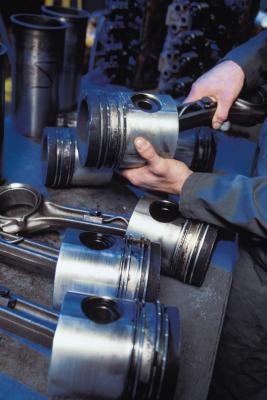
Carbon build up in a two-stroke engine tends to be quite common since the basic design of the engine requires both gasoline and engine oil to be consumed and burned simultaneously. This approach causes quite a bit of combustion to occur right in the cylinder head and the exhaust spigot coming out of the cylinder chamber. To remove this buildup, regular removal of the most exposed parts tends to be required to clean them properly with a solvent, brush and sometimes a small wood block. The below steps assume the engine has already been removed from its vehicle.
Place the engine on a workbench. Remove the spark plug cap from the spark plug. Use a socket wrench to loosen and remove the spark plug. Use the same tool to loosen the cylinder nuts. Unscrew them until they come off. Remove the washers underneath. Carefully pull the cylinder cap from the cylinder studs until free.
Place the cylinder cover under a light. Examine amount of carbonization that has built up on the inside of the cap. Use a small wood block and hammer to chisel off some of the crustier pieces from the cap. Only make contact with the wood on the cap, not the hammer.
Spray the cap carbon with carburetor cleaner or a similar solvent. Let it soak in for a minute or two. Spray the cap again. Scrub the carbon off the cap with a plastic brush or an old toothbrush. Keep scrubbing until most of the carbon comes off. Wipe it occasionally with a shop rag and continue spraying until clean.
Give the cap one additional spray with carburetor cleaner to wash it down and dry it off with a clean shop rag. Let it sit until completely dry. Go back to the cylinder and use a socket wrench to loosen the exhaust off the cylinder exhaust stub. Pull the exhaust off. Use the screwdriver to lever off the exhaust stub until loose by notching into the exhaust stub rim gaps. Twist until loose.
Wash and scrub the exhaust stub clean the same way that you cleaned the cylinder cap in Step 3. Take the now-dry cylinder cap and place it back onto the engine cylinder studs. Slide it into place against the cylinder. Insert new washers and nuts. Tighten down the cylinder cap with a torque wrench to the settings for your two-stroke engine.
Take the cleaned out exhaust stub and screw it back into the bottom of the cylinder. Tighten it with the screwdriver notched in the stub gaps. Reinsert the exhaust and tap it into the stub with a rubber mallet. Tighten the exhaust neck onto the stub with a socket wrench.